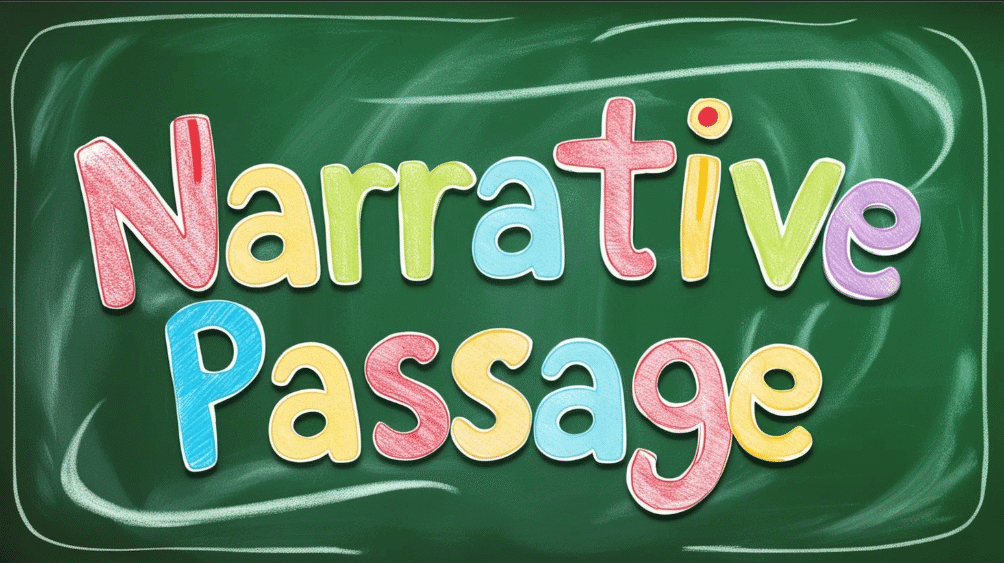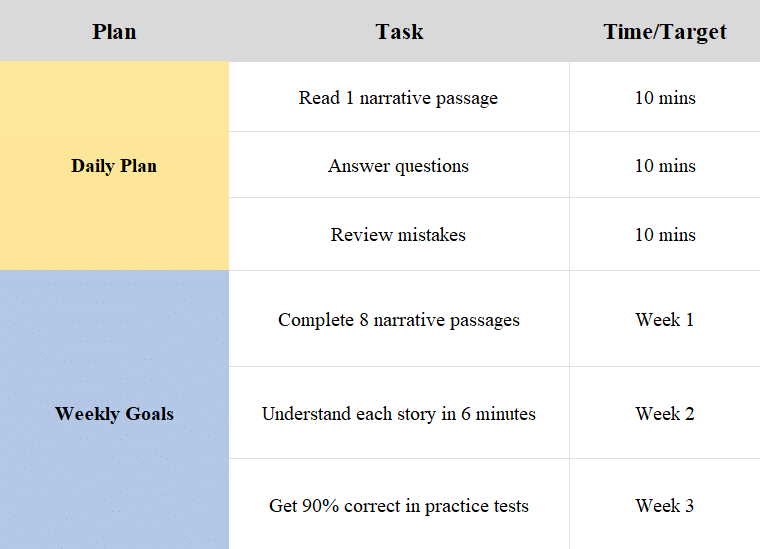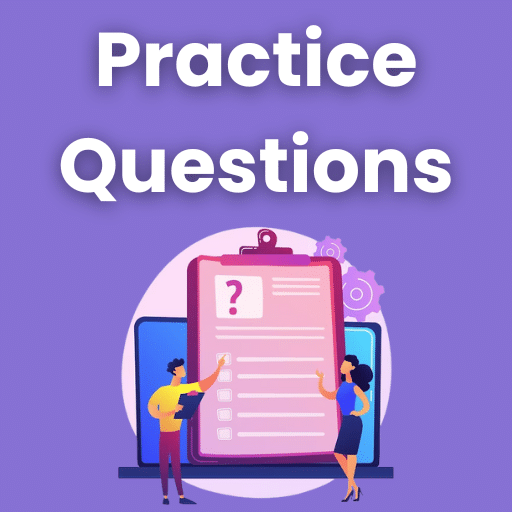Introduction to Narrative Passage | English Language Preparation for CUET UG PDF Download
| Table of contents |

|
| Question Types You’ll Encounter |

|
| CUET Narrative Passage Preparation Tips |

|
| What Toppers Do to Win at Passages |

|
| EduRev's Tips |

|
| Try It Out: Test Your Skills |

|
| Key Takeaways |

|
Narrative Passages: The Storytelling
To do well in CUET, you can’t just focus on numbers or facts—you also need to get good at narrative passages. These are interesting stories that test how well you understand plots, characters, and hidden meanings, all while you’re short on time. They’re worth 25-35 marks, so mastering them can really help you stand out and boost your CUET score big time.

What is a Narrative Passage?
A narrative passage is a text that tells a story. It includes characters, events, settings, and a plot, often with a beginning, middle, and end. Unlike factual passages, narratives blend description with emotions and perspectives, requiring you to analyze both what happens and why it matters. These passages test comprehension, inference, and your ability to connect ideas.
Question Types You’ll Encounter
- Plot-Based Questions (Direct Answer): These ask about events or details in the story.
Example: “What did the protagonist do after the storm?”
Answer: Took shelter in a cave. - Character-Based Questions: Focus on traits, motivations, or actions of characters.
Example: “Why did Ria refuse to leave?”
Answer: She wanted to protect her home. - Theme or Moral Questions: Require identifying the central message or lesson.
Example: “What is the main idea of the passage?”
Answer: Courage in adversity. - Inference-Based Questions: Ask you to read between the lines.
Example: “What can be inferred about Ria’s personality?”
Answer: She’s stubborn yet brave.
CUET Narrative Passage Preparation Tips
Exam Pattern Familiarization
- Understand the structure of the CUET narrative passage section: number of questions, time allotted, and question variety (plot, character, inference).
Active Reading Techniques
- Initial Scan: Quickly read to identify the setting, characters, and main event.
- Detailed Reading: Focus on emotions, turning points, and character actions.
- Highlight Information: Mark key moments, dialogues, or descriptive words that hint at themes.
Question Analysis
- Read Carefully: Look for clues in the question (e.g., “why” vs. “what”).
- Keyword Matching: Connect question words (e.g., “motive,” “event”) to the passage.
- Avoid Assumptions: Stick to the story—don’t invent details not provided.
Mock Test Practice
- Past Papers: Solve previous CUET narrative questions to get comfortable with storytelling styles.
- Review Mistakes: Identify where you misread emotions or overthought inferences.
Vocabulary Enhancement
- Regular Reading: Read short stories, novels, or literary magazines to grasp narrative flow.
- Context Clues: Decode unfamiliar words (e.g., “forlorn” = sad) from the story’s tone.
Time Management
- Pacing: Spend 1-2 minutes scanning, then allocate time per question.
- Question Skipping: Move past tricky inference questions and revisit if time permits.
These steps will sharpen your ability to tackle narrative passages effectively.
What Toppers Do to Win at Passages
Currently pursuing BA Political Science (Hons) at Hindu College, Delhi University
- Make Your Own Notes: Jaya made detailed notes from NCERTs for all her subjects (Political Science, History, English, Psychology). She included small details like timelines and boxes from the chapters.
- Use Board Prep Smartly: She started CUET prep before her Class 12 boards. Since her first-term board exams were MCQ-based, it gave her a head start for CUET’s format.
- Stay Consistent: Jaya didn’t join coaching but studied on her own every day. She says sticking to a simple routine and revising regularly is what worked.

Key Advice: "Prepare notes early and keep going over them. If your concepts are clear, CUET is easy."
 |
Download the notes
Introduction to Narrative Passage
|
Download as PDF |
EduRev's Tips
"Choose a calm place to focus on understanding characters and plots.
Set a timer to practice finishing questions under exam pressure."

To-Do
- Solve 1 narrative passage today
- Note 5 emotional or descriptive words
- Finish 1 practice test by Sunday
Key Tips
- Focus on the story’s flow, not just isolated details
- Be empathetic—understand characters’ feelings
- Stay calm, read with curiosity, and avoid rushing
Follow this consistently for CUET success.
Extra Trick: Try CUET narrative mock tests on EduRev to practice timing.
Try It Out: Test Your Skills
Mini Passage for Practice
“In a quiet village nestled in the hills, young Arjun faced a dilemma. A fierce storm had destroyed the only bridge connecting his home to the town, leaving his family stranded. His mother urged him to wait for help, but Arjun, driven by a mix of fear and determination, ventured into the rain. He spent hours gathering fallen branches, hoping to build a raft. By dusk, exhausted but resolute, he succeeded—just as rescuers arrived. The ordeal taught him that courage often blooms in the shadow of doubt. In 2024, Arjun’s story inspired 1,200 students at a CUET motivational seminar.”
Questions
What did Arjun do after the storm destroyed the bridge?
a) Waited for help
b) Built a raft
c) Called the town
d) Left the village
 View Answer
View AnswerAnswer: b) Built a raft
Trap: Option a) tempts those who skim and miss Arjun’s actions.
Why did Arjun act despite his mother’s advice?
a) He didn’t trust her
b) He was bored
c) He felt determined
d) He wanted fame
 View Answer
View AnswerAnswer: c) He felt determined
Trap: c) requires spotting “determination” in the text, not assuming fame (d).
What can be inferred about Arjun’s character from the passage?
a) He’s lazy but lucky
b) He’s brave and persistent
c) He’s reckless and impatient
d) He’s weak but clever
 View Answer
View AnswerAnswer: b) He’s brave and persistent
Trap: c) might lure those who misread his effort as rashness.
Key Takeaways
You’ll find many ways to ace narrative passages for CUET 2025 with focused preparation:
- Develop a reading habit—short stories, novels, or even movie plots improve narrative sense.
- Underline key events, emotions, and dialogues to deepen your grasp of CUET narrative passages.
- Anticipate questions about characters and themes, answering only with passage details.
- Solve past papers and mock tests to master question styles and pacing.
- Build vocabulary for emotions and descriptions—use flashcards or story-based word lists.
Cheer: “Each story you crack brings you 5 points closer to your CUET goal!”
|
70 videos|84 docs|90 tests
|
FAQs on Introduction to Narrative Passage - English Language Preparation for CUET UG
| 1. What is a narrative passage? |  |
| 2. What are the key components of a narrative passage? |  |
| 3. How do I identify the main theme of a narrative passage? |  |
| 4. What techniques can I use to analyze a narrative passage effectively? |  |
| 5. Why is understanding narrative passages important for reading comprehension? |  |




















